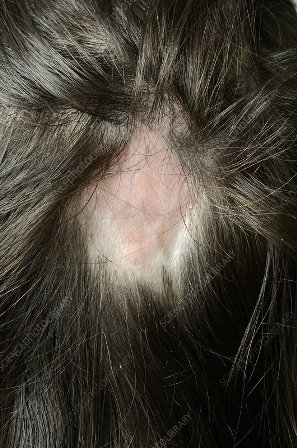Alopecia is the term used for hair loss. Hair is made up of protein, and it grows from the follicle which is in the dermis of the skin. In the case of scarring alopecia also known as cicatricial alopecia, there is inflammation of follicles followed by their destruction, and the injured area is replaced by fibrous tissue giving rise to a scar, which may be due to increase or decrease pigmentation. So, every hair that falls leaves a defect behind. This leads to permanent damage to the follicle and it can no longer allow the growth of hair.

Scarring Alopecia Treatment depends upon the underlying pathology. The disease can be primary or secondary. In the case of primary disease, the inflammatory process directly targets the follicle, however, in the case of secondary disease damage to follicles occurs secondary to some other cause which can be trauma, burn, or a tumor.
Classification of Scarring Alopecia
It can be classified based on cells involved in inflammation
- Lymphocytic (White blood cells involved in chronic inflammation)
It is thought to be an autoimmune disorder in which the body’s immune cells start attacking host cells and tissue, including hair cells. 10% of the people have this type.
- Chronic cutaneous lupus erythematosus
It arises due to some abnormality at the level of the gene. It can also take place due to continuous exposure to Ultraviolet light in the sun which damages the follicles.
- Centrifugal cicatricial
It is common in African people.
- Neutrophilic (White blood cell majorly involved in acute inflammations and bacterial infections)
- Folliculitis decalvans
It is a pathogenic disease caused by the bacteria, Staphylococcus aureus.
- Dissecting cellulitis of the scalp
This can happen as a result of the blockage of follicles.
Scarring alopecia treatment involves the use of medicines and surgery for hair restoration and aims at limiting hair loss. Hair loss leads to a permanently damaged follicle that cannot be reversed. The goal of treatment is to restrict the further loss and progression of the disease. The disease may present itself in the form of bald patches and smooth skin. So, early and accurate diagnosis is very important to limit the damage and to prepare proper treatment.
Lichen planopilaris
Treated with topical and oral corticosteroids which limit the inflammation.
Calcineurin inhibitors. Calcineurin is an activator of immune cells.
Chronic cutaneous lupus erythematosus
Topic corticosteroids
Anti malarial such as hydroxychloroquine.
Retinoids
Limited sun exposure and the use of hats can also benefit.
Centrifugal cicatricial
Topical corticosteroids
Folliculitis decalvan
Antibiotics such as rifampicin, clindamycin, doxycycline, fusidic acid along with zinc.
Dissecting cellulitis of the scalp
Oral isotretinoin
Oral corticosteroids
Hair Growth Medicines
Medicines such as minoxidil which are proven to be effective for androgenic alopecia may not be useful in this case. The reason behind this is, there is irreversible damage due to the death of cells which allows the hair cell to regenerate.
Surgery
Surgery in the form of hair transplants is an option for covering the bald patches, provided there are some healthy donor follicles. Surgery for the bald area is only beneficial when the cause of the disease is completely treated. If the disease is ongoing, it will also damage the newly harvested follicle and not allow them to grow.
A transplant can be done using any of these techniques, scalp reduction, flap rotation, follicular unit extraction, and follicular unit transplant.
How long does it take for a treatment?
Scarring alopecia treatment involves prolonged and continued use of medicines until the signs and symptoms of the disease completely disappear. Reactivation of the disease is common, so regular follow-up is advised even after the symptoms are resolved. Compliance of the patients is essential for the desired results.
